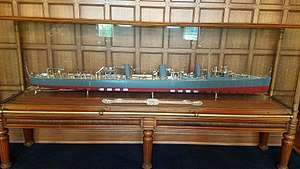HMS Violet (1897)
HMS Violet was a Doxford three-funnel, 30-knot destroyer ordered by the Royal Navy under the 1896–1897 Naval Estimates. She was the seventh ship to carry this name since it was introduced in 1588 for a 200-ton vessel.[3][4]
 HMS Violet scale model located at Olde World Canterbury Village in Lake Orion, MI | |
| History | |
|---|---|
| Name: | Violet |
| Ordered: | 1896 – 1897 Naval Estimates |
| Builder: | William Doxford and Sons Pallion, Sunderland |
| Laid down: | 13 July 1896 |
| Launched: | 3 May 1897 |
| Commissioned: | June 1898 |
| Out of service: | Laid up in reserve 1919 |
| Fate: | Sold for breaking, 7 June 1920 |
| General characteristics | |
| Class and type: | Doxford three-funnel, 30-knot destroyer[1][2] |
| Displacement: |
|
| Length: | 214 ft (65 m) o/a |
| Beam: | 21 ft (6.4 m) |
| Draught: | 9 ft 7 in (2.92 m) |
| Installed power: | 6,300 shp (4,700 kW) |
| Propulsion: |
|
| Speed: | 30 kn (56 km/h) |
| Range: |
|
| Complement: | 63 officers and men |
| Armament: |
|
| Service record | |
| Operations: | World War I 1914 - 1918 |
Construction and career
She was laid down on 13 July 1896, at the William Doxford and Sons shipyard in Pallion, Sunderland, and launched on 3 May 1897. During her builder's trials, she made her contracted speed requirement. She was completed and accepted by the Royal Navy in June 1898.[3][4] After commissioning she was assigned to the Devonport Flotilla and spent her entire career in home waters.
She underwent repairs to re-tube her boilers in 1902.[5] On 9 July 1907 Violet collided with a sailing vessel, badly damaging the destroyer's bow and slightly injuring three of her crew. She was towed stern first to the Nore by the destroyer Falcon before being taken into Sheerness for repair.[6] Violet was refitted at Pembroke Dockyard in 1909, having her bow replated and her boilers retubed.[7]
On 30 August 1912 the Admiralty directed all destroyer classes were to be designated by alpha characters starting with the letter 'A'. Since her design speed was 30 knots (56 km/h; 35 mph) with three funnels, she was assigned to the C Class. After 30 September 1913, she was known as a C-class destroyer and had the letter ‘C’ painted on the hull below the bridge area and on either the fore or aft funnel.[8]
World War I
August 1914 found her in active commission in the 7th Destroyer Flotilla based at Devonport tendered to HMS Leander. She served there until September 1917 when she was sent to join the local defence flotilla at the Nore.[9]
In April 1918 she was reassigned to the 6th Destroyer Flotilla and the Dover Patrol.[10] She remained in this deployment for the duration of the First World War. Her duties included anti-submarine, counter-mining patrols, and patrolling the Dover Barrage.
In 1919 she was paid off and laid-up in reserve, awaiting disposal. Violet was sold on 7 June 1920 to J Houston of Montrose for breaking.[11]
Pennant numbers
| Pennant number[11] | From | To |
|---|---|---|
| D09 | 6 December 1914 | 1 September 1915 |
| D73 | 1 September 1915 | 1 January 1918 |
| D94 | 1 January 1918 | 7 June 1920 |
References
Note: All tabular data under general characteristics only from the listed Jane's Fighting Ships volume unless otherwise specified
- Jane, Fred T. (1969) [1905]. Jane’s Fighting Ships 1905. New York: first published by Sampson Low Marston, London 1905, Reprinted ARCO Publishing Company. p. 77.
- Jane, Fred T. (1990) [1919, reprinted]. Jane’s Fighting Ships of World War I. Jane’s Publishing © 1919. p. 77. ISBN 1 85170 378 0.
- Jane, Fred T. (1969) [1898]. Jane's All the World's Fighting Ships 1898. New York: first published by Sampson Low Marston, London 1898, Reprinted ARCO Publishing Company. pp. 84 to 85.
- Jane, Fred T. (1990). p. 76.
- "Naval & Military intelligence". The Times (36767). London. 14 May 1902. p. 12.
- "Naval Matters—Past and Prospective: Sheerness". The Marine Engineer and Naval Architect. Vol. 30. 1 August 1907. p. 16.
- "Naval Matters—Past and Prospective: Pembroke Dockyard". The Marine Engineer and Naval Architect. Vol. 32. September 1909. p. 57.
- Conway's All the World's Fighting Ships 1906–1921. Conway Maritime Press. 2006 [1985, reprinted 1986, 1997, 2002, 2006]. pp. 17 to 19. ISBN 0 85177 245 5.
- Monthly Supplements to the Navy List, September 1914 through September 1917.
- Monthly Supplements to the Navy List, September 1917 through December 1918.
- ""Arrowsmith" List – Part 1 Destroyer Prototypes through "River" Class". Retrieved 1 June 2013.
Bibliography
- Chesneau, Roger & Kolesnik, Eugene M., eds. (1979). Conway's All The World's Fighting Ships 1860–1905. London: Conway Maritime Press. ISBN 0-85177-133-5.
- Colledge, J. J.; Warlow, Ben (2006) [1969]. Ships of the Royal Navy: The Complete Record of all Fighting Ships of the Royal Navy (Rev. ed.). London: Chatham Publishing. ISBN 978-1-86176-281-8.
- Dittmar, F. J. & Colledge, J. J. (1972). British Warships 1914–1919. Shepperton, UK: Ian Allan. ISBN 0-7110-0380-7.
- Friedman, Norman (2009). British Destroyers: From Earliest Days to the Second World War. Barnsley, UK: Seaforth Publishing. ISBN 978-1-84832-049-9.
- Gardiner, Robert & Gray, Randal, eds. (1985). Conway's All The World's Fighting Ships 1906–1921. London: Conway Maritime Press. ISBN 0-85177-245-5.
- Lyon, David (2001) [1996]. The First Destroyers. London: Caxton Editions. ISBN 1-84067-3648.
- Manning, T. D. (1961). The British Destroyer. London: Putnam & Co. OCLC 6470051.
- March, Edgar J. (1966). British Destroyers: A History of Development, 1892–1953; Drawn by Admiralty Permission From Official Records & Returns, Ships' Covers & Building Plans. London: Seeley Service. OCLC 164893555.